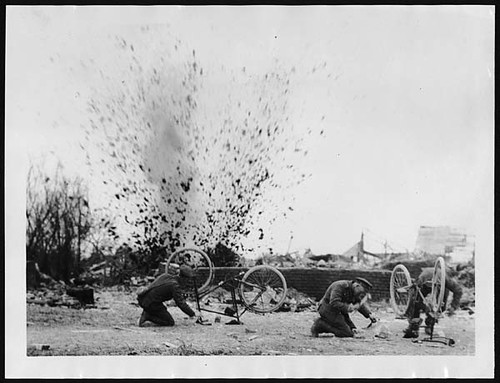 Bicycles in War by Martin Caidin
Bicycles in War by Martin CaidinMy rating: 3 of 5 stars
The record doesn't give credit to a co-author, Jay Barbree, who seems to have written books mostly about space exploration, including at least one other book written with Martin Caidin.
My father and his older brother both served in the U.S. Army during WWII and both were interested in aviation - they owned a plane together for a while. Growing up I didn't use the public library very much (it wasn't particularly close by) and read a lot of my father's books about WWII that included four or five books written by Martin Caidin about different U.S. fighters and bombers and their use during the War. I certainly remember them as engaging my attention - I'm pretty sure I read several of them more than once.
I got this out of the library where I work. It is probably not readily available these days.
Caidin's usual approach with his military aviation books was to describe the development of the aircraft and then to describe examples of its use in combat, focusing on particular pilots and units. Caidin and his co-author don't appear to have known that much about bicycles or otherwise think that the readers would be interested in the development of bicycles for use in war so that subject is not presented - the focus is on their use in several particular examples, including World War I, World War II, and the Vietnam War. He spends about 20 pages on the famous (in certain circles . . . ) 1,900 mile "march" of the 25th Infantry Corps (that was an all African American unit, except for the officers) in 1897 from Missoula, Montana to St. Louis, Missouri. The story of this unit is now covered quite well be various sources on the Internet, including this day-by-day account, the 25th Bicycle Corp, a page at the Fort Missoula Museum web site, and an hour long video, "The Bicycle Corps: America's Black Army On Wheels" (2000).
The Fort Missoula Museum site provides some of the technical information lacking in the book, for example:
Moss contacted the A. G. Spalding Company, who agreed to provide military bicycles co-designed by Moss at no cost. The Corps, consisting of eight black enlisted men, soon was riding in formation, drilling, scaling fences up to nine-feet high, fording streams, and pedaling 40 miles a day. Each bicycle carried a knapsack, blanket roll, and a shelter half strapped to the handlebar. A hard leather frame case fit into the diamond of each bicycle and a drinking cup was kept in a cloth sack under the seat. Each rider carried a rifle (first slung over the back, later strapped to the horizontal bar) and 50 rounds of ammunition.For someone like me, with my interested heavily towards what the bicycles were like, this wasn't a particularly satisfying book. On the other hand, given that there isn't much published on this topic and was readily available (to me) it was a good enough read.
The Spalding military bicycles were furnished with steel rims, tandem spokes, extra-heavy side-forks and crowns, gear cases, luggage carriers, frame cases, brakes, and Christy saddles. They were geared to 68 inches and weighed 32 pounds. The average weight of the bicycles, packed, was about 59 pounds.
There are some b&w photographs included - nothing particular special alas, but then these are the days of the Internet and the book was published in 1974. I had seen many of those used before, but when the book was published, they were likely unusual to see.
 "Cycle orderlies under fire" - one of the photographs in the book, now widely published on the Internet (and even available for purchase from Getty Images, if you want to spend money)
"Cycle orderlies under fire" - one of the photographs in the book, now widely published on the Internet (and even available for purchase from Getty Images, if you want to spend money)View all my book reviews of books on cycling at Goodreads.